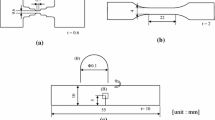Abstract
The process of hydrogen embrittlement of zirconium alloys caused by the pressure of molecular hydrogen in voids formed near threefold junctions of grain boundaries and by volume changes due to formation of hydride phases is considered. The embrittling mechanisms are physically based on the diffusion processes near structural imperfections, the leading role among which belongs to threefold junctions of grain boundaries. These structural defects possess strong stress fields and directly adjoin grain boundaries.
Similar content being viewed by others
REFERENCES
N. M. Vlasov and V. A. Zaznoba, “Diffusion processes in the neighborhood of threefold junctions of special grain boundaries,” Fiz. Tverd. Tela, 41, Issue 1, 64–67 (1999).
N. M. Vlasov and I. I. Fedik, “Layering of the solid solution in the field of residual stresses,” Dokl. Ross. Akad. Nauk, 382(2), 186–189 (2002).
V. M. Vlasov and I. I. Fedik, “Hydrogen segregation in the area of three fold junctions of grain boundaries,” Int. J. Hydrogen Energy, 27, 921–926 (2002).
B. A. Kolachev, Hydrogen Brittleness of Metals [in Russian], Metallurgiya, Moscow(1985).
Author information
Authors and Affiliations
Rights and permissions
About this article
Cite this article
Vlasov, N.M., Fedik, I.I. Hydrogen Embrittlement of Zirconium Alloys. Metal Science and Heat Treatment 45, 328–331 (2003). https://doi.org/10.1023/A:1027353023401
Issue Date:
DOI: https://doi.org/10.1023/A:1027353023401




